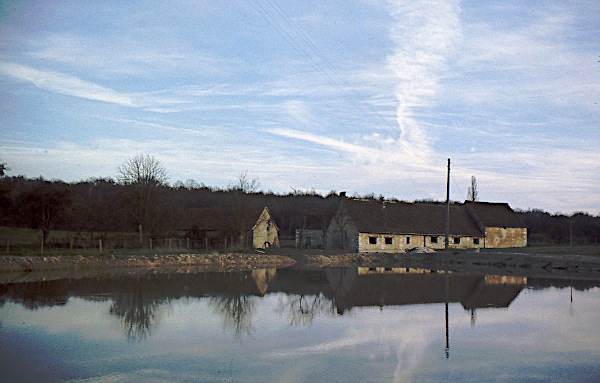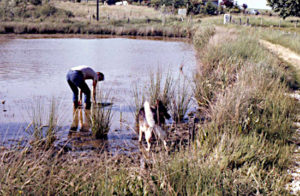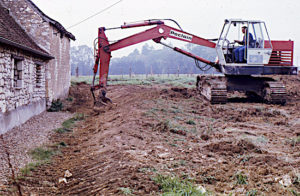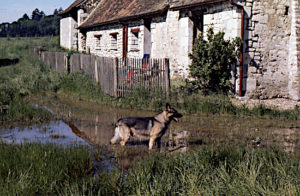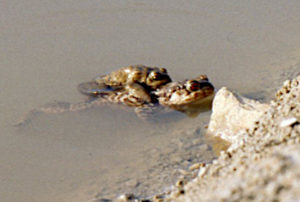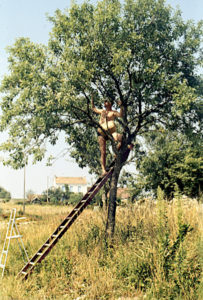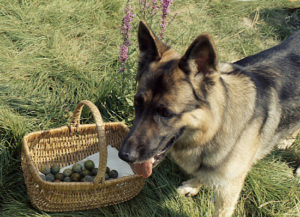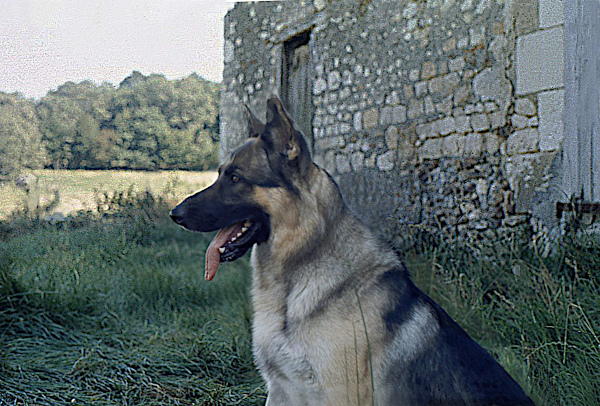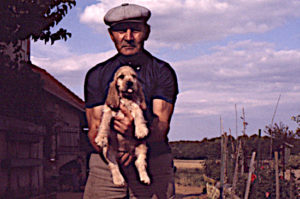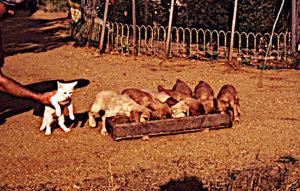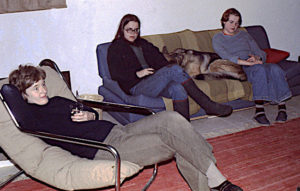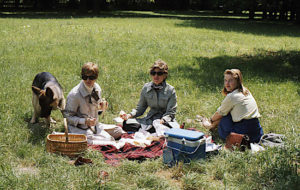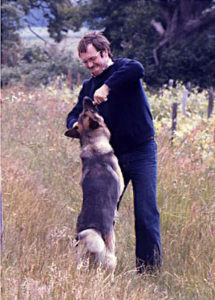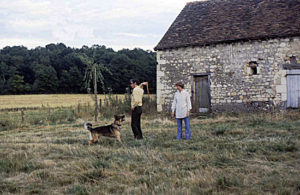Chapter 26 – (Part 2) La Fontaine, Drought and flood
(Click on the pictures for larger versions)
The most dramatic events at La Fontaine occurred during the year of the drought, 1976, and the following year of the flooding, Those were somewhat difficult summers, but in the end it served us well.
We got the muddy little pond cleaned up, and then we got a beautiful grassy area behind the house which had been landscaped the right way.
Monsieur Bourreau was the man who came with a backhoe and did all the work that had to be done to clean the pond and to get the area around it in good shape. (M. Bourreau is an easy name to remember since le bourreau means the hangman.) And that’s when the ugly hole behind our house that had been the site for all sorts of garbage, nettles and horrible bramble bushes, was now finally filled in. It could just not have been done without a backhoe, so all turned out for the best. Pretty soon thereafter, grass was growing in the place of the former hole. For us, M. Bourreau was the man who set everything right after a great deal of hardship. And of course he too had un petit verre in our kitchen, not once, but many times.
Since the well had to be cleaned out too, a big problem was of course the water going into the house. Heaven only knows how we managed to get any water at all. However, one way or another we managed.
John says the water he and Puppy were getting from the pond here was for watering the young willow trees. What we did for washing and cooking water is a mystery.
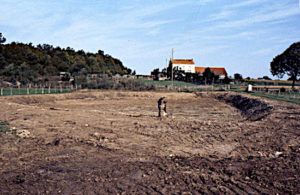
This was one the dirty little ‘fosse’ and it will soon become a nice-looking little pond. M. Thogniard’s house in the background.
As John seems to remember, we showered in the water from the well and washed the dishes in it too, possibly rinsing with bottled water, he says. Maybe we got loads of mineral water, the way we do in India.???
The flooding the following year, 1977, was a gift from heaven (or at least from the sky), but for Puppy – and for us too – it had certain problems. Puppy wasn’t much aware of any such problems though. But geez, I never saw a dirtier dog.
However, the final result of all the remaking of the pond and the land around it was great. It was made possible only because of the whims of the weather king. (John calls Thor my first husband, and Siv was indeed Thor’s wife.)
There was an awful lot of Puppy cleaning to be done in the year
of the flooding, such as every time he had been out in the dirty puddles in front of the house, which was just about all the time. I am not including here a picture of horribly dirty Puppy by the kitchen door. My handsome dog who was so perfect the original owner wanted to buy him back for quite a good price, about ten times more than we had paid for him. (Maybe I am exaggerating some here.) We wouldn’t even think of it of course, which M. Rothling knew perfectly well.
Puppy did fairly well at his first dog show, even if when he was running in the ring, he kept looking back for mummy. It was M, Rothling himself who ran him. German shepherds run, they don’t walk in a show. M. Rothling told us that all he needed was some more muscles and that we should have him run by a bike 9 km every day. We never understood why 9 and not 10. But that made us buy bikes for the country, which we carried down on one trip on the top of our little Peugeot 204, the same as we did with the mattresses that became our sofa.
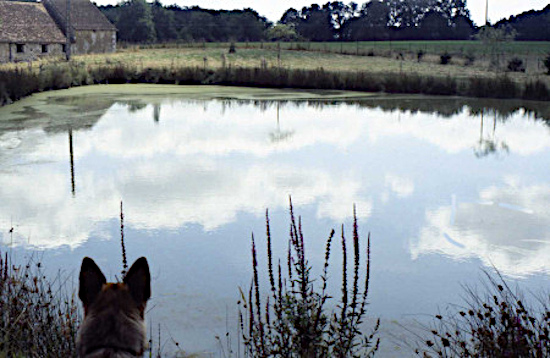
After an evening walk Puppy and I sat down at the far end of the pond. Here is Puppy’s head showing above the edge of the “new” pond.
M. Thogniard turned out to be a very good and a very helpful neighbor. One summer he had heard and seen that there were plenty of frogs in our pond, he told us that if we liked frog legs, he would catch some frogs that we could take back to Paris and have for dinner
As it happened, he caught a whole lot, using a flower as a bait!!! He then cleaned them, prepared them (which I could never have done), and all that was left for us to do was the sheer pleasure of frying them with lots of garlic (salt and pepper) and eat them. Frog legs are a delicacy. It’s said that they taste like chicken, but as they say in this gourmet country. C’est plus fin.
I would say beaucoup plus fin, and of course the garlic gives it a very special Mediterranean taste that beats chicken any time. By a long shot. I find that even in good restaurants here in France, they very often don’t use enough garlic. Maybe next time I order frog legs, I’ll ask them not to spare the garlic. Yes, I will definitely do that.
Let’s Do It (Let’s Fall In Love) by Ella Fitzgerald (music by Cole Porter)
Oh, divine Ella.There has never been another one like her.
This was just an association that came to my mind as I looked at the picture John took. So even frogs do it. “Even educated flees do it” is, I believe, one of the funniest song lines ever written. Good old Noel Coward, whose very memory has probably gone to the grave by now. How sad.
M. Thogniard was extremely helpful in another case as well. He pointed out that we should harvest all the reine claude plums we had on two trees in a little orchard next to the left-side barn. The little area had been so overgrown with nettles that it would never have occurred to us that there might be something useful in that corner.
However, we magically got rid of those nettles and also a whole lot that vilified the far end of the house. It was most likely wonderful M. Poitou who told us to buy a product to kill ‘chiendent‘, a word we had never known until that first summer at La Fontaine. So we did, and the nettles magically disappeared and in both places were replaced by beautiful green grass. Sheer magic.
Now M. Thogniard told us we should get preserve jars and what goes along with those and he would lend us a huge pan (casserole) to do the preserving in.
Off we went to the hardware store, where we were already good customers. They were wonderful and told us about all the details in applying the rubber rings, put the clamps on and then boil the jars in a big (enormous, in fact) pot for such and such a time. That was a fabulous experience and I don’t know how many delicious plum pies (tartes) those plums made. I do remember however that years later I opened the last jar to make a plum tarte for a student / teacher party at l’Ecole Centrale.
__________________
Our helpful neighbor also had a very interesting hobby. He bred cocker spaniels, I think they were the kind they call American, for some reason, the light color, I think. We liked his little white cat, Miquet, but to see all his six cocker spaniel puppies together was a really special sight.
Among our friends and family who visited us at La Fontaine, mainly over weekends, was of course Kajsa first of all, and once with her friend and roommate, Lillan, at the Maison de Suède at the Cité Universitaire where she was staying during her second year in Paris ’76-77. To get Kajsa a room at the very last minute, I wrote to the direction of La Maison de Suède, letting them know that a relative of ours, Harald Jacobson, had quite some time ago donated a lot of money to the foundation (or whatever it was), and asked them if they would please consider this. Following my letter they managed to get her to share a room will Lillan. Kajsa was pleased, and Lillan was pleased, so all worked out for the best. “Lillan” was clearly a nickname that she had born ever since she was a baby. Lillan wrote poetry that was quite good, and she was quite a character. She too became a member of the family, and we even met her parents who took us to dinner at Place de l’Odéon in a nice restaurant.
The fact was that farbror (Uncle) Harald Jocobson, as Arne called him, had inherited Arne’s grandfather’s import business (he was the first importer of bananas in Sweden), a profitable business that eventually ended up being bought by NK, Nordiska Kompaniet. When he died in 1950, all Arne got was a symbolic sum that made it possible for us to travel very comfortably to Lapland again, all four of us. But the large part of his fortune did not even go to Tante Gerda whose father had made the fortune in the first place, but obviously to foundations and charities.
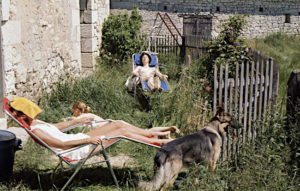
Three sunbathers in front of our house. Kajsa left the two deckchairs for her elders. She is lying on the ground.
After Kajsa and my sister Gun and then my parents-in-law, our next visitor was John’s sister Marjie, who came to visit us in Paris. She came with us to La Fontaine and seemed to like it, in spite of its primitive setup. The assainissement had certainly been finished by then, even if John hadn’t yet painted gutters and drainpipes yet. She was at La Fontaine at the same time as Kajsa, and, among other things, we all went to Chenonceau together. La vallée de la Loire is not far from La Fontaine and we made several little trips from there to various châteaux.
In fact, back in Paris we also went to Versailles together and to other châteaux as well. Versailles is of course a palace, and an immense one at that.
And there was Roberto, our unique Argentinian friend who was with us several times at La Fontaine. When he moved back to Buenos Aires, he left an enormous void behind. In fact we went to Argentina to visit him and his wonderful partner, Marta. They also visited us in Paris and, later on, in Genas. We had to leave Paris and a lot of good friends behind in 1986. Very sad, but the CCPN (Centre de Calcul de Physique Nucléaire), the computing center where John was a systems engineer was decentralized from Paris to Lyon, and we had to follow.
And of course there were Jürgen and Ruth, some of our Paris friends that we missed the most. They came to La Fontaine a couple of times and it was always nice seeing them with us. I talk a lot about these dear friends in another chapter.
Jürgen and I were colleagues at l‘Ecole Centrale, and Ruth did some teaching there too, but she principally taught German at l’Ecole Normale Supérieure. They were very good friends ever since the beginning of our living in Paris, and we even knew their families. We had been to Jürgen’s family’s “Hotel Loisach” in Lermoos, Tirol. Their hotel was too expensive for us, but we ate in the restaurant a couple of times, as we were staying in a B&B in Erwald, which is right next door. We saw their old Saint Bernard dog who was already old at the time and mostly lay sleeping on the floor in the entrance hall.
Even Jürgen doesn’t remember her name. We also went to see die Loisachquelle, a spring out in the woods, which had given the name to the hotel. I have loved those springs in the forest ever since Mother took us to one in a Småland forest when we were very young. I will never forget dipping my face in the cool clean water and drinking the best water I’ve ever tasted. An epiphany at the age of 5 or so.
The same year as Lermoos, 1980, we also traveled to Mittelberg, Ruth’s family’s vacation home in the very northernmost part of Austria, right on the German border. It was an adorable red wooden house. We got to know her very nice parents and we even saw them later in Paris. (Chapter 25) Another memorable event was the hail storm we saw from inside the house – luckily. The hail was as big as golf balls (I possibly exaggerate a bit here) and we watched it accumulate on the balcony with great awe.
Mittelberg doesn’t seem to have the dramatic hiking paths that our dear Brandnertal offers, but much more about Brand in later chapters. We had a very pleasant hike with Ruth however on that one day we were staying in Mittelberg – before the hail storm.
In 1978, the year we finally had to sell the house, our friends Wes and Patsy plus their two sons came down from Nijmegen in Holland.
Wes was a particle physicist like John and a colleague of his from Brookhaven National Laboratory on Long Island. Wes then went on to Ecole Polytechnique in Paris, which was at the time located in rue des Ecoles, a stone’s throw from Collège de France where John did a three-year stint a year or so after Wes worked at L’Ecole Polytechnique, or l’X as it is usually called. The school and research center later moved to Palaiseau, a southern suburb of Paris. Wes and John overlapped for one year in Paris, and John found a friendly place at Wes’s and Patsy’s home in Paris.
After l’Ecole Polytechnique, Wes accepted a position at Nijmegen University, since there were just no jobs to be had in the U.S. at all – as John was going to find out about a couple of years later. Wes made a brilliant career at Nijmegen University, and we saw the family often, in Paris, in Nijmegen and in Genas. They also later came with us in the early 80s to Haus Kella-Egg in Brand, our “home” in Vorarlberg, Austria. I remember Patsy speaking Dutch to Gerti, our adorable landlady and friend, and Gerti speaking German to Patsy. It seemed to work.
We have stayed in touch with the family, and we may well one summer go to Edinburgh, the beautiful city in Scotland where we have never been, to see their son Mark who lives there with his Dutch wife and their daughters. We went to the Highlands every time we went to Scotland and we love the country.
It happened to be very good for us having an entire family visiting us that summer. We had to sell our beloved house since that year when we came down for the summer there was mold all over the place. We just could not keep up with all the cleaning work every time we came down.
This time we had been away for too long, and there was mold inside both armoires, mold on the beams in the ceiling of the living room and I believe even on the paint in between the beams, that I had painted. We cleaned it all up, aired the house and especially the two armoires, and put it up for sale.
The people who showed up one sunny day when Wes and family were there must have got a good impression of how livable the house was — in spite of the horrible bathroom. The pond was gorgeous with the young willow trees and a spruce, and they could well see all the work that had been done on the house for the assainissement.The bathroom was a bit of a downpoint, but it had a shower, a sink and a toilet and hot and cold water, so what was missing was mainly looks. But there were so many positive points, especially since this family lived in Orléans, a very short distance away compared to Paris. We sold it to them and we got an acceptable price.
More pictures from La Fontaine over the years
ngg_shortcode_0_placeholder
Continued: Chapter 27 – Travels with Family in 1974
